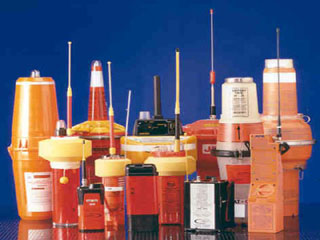EPIRB
From CruisersWiki
EPIRB
(Emergency position-indicating radio beacon)
Current marine EPIRBs are generally divided into three classes; Category I, Category II, and Class B (or Category B).
- Category I EPIRBs are considered the best but are also the most costly. The Category I - type is recommended by the IMO because a float-free bracket will deploy automatically once the vessel sinks and the EPIRB will then be activated automatically by immersion in water in the event of a disaster at sea. These EPIRBs are generally housed in a specially designed bracket on deck and the buoyant beacon is designed to rise to the surface and emit two signals, an emergency homing signal on 121.5 MHz and a digital identification Hex Code on 406 MHz that can be used to almost-immediately alert SAR authorities of the distress of the stricken vessel. Category I EPIRBs used in American waters must be registered with NOAA.
- Category II EPIRBs are similar to Category I EPIRBs but are generally manual deployment only. Also like Category I EPIRBs, Category II units must be registered. Category II EPIRBs are also generally less costly averaging less than US$1,000.
- Class B EPIRBs, also called Category B or "Mini B", operate a 121.5 MHz homing signal only and are usually manual deployment only units. They are the cheapest units but also the least capable. Since the signal has no identification component, Class B EPIRBs are not registered. Due to their limitations, Class B EPIRBs are slowly being phased out. As the International Cospas-Sarsat program no longer monitors Category B EPIRB signals as of February 1, 2009, this type of beacon will become fully obsolete. Although the U.S. Coast Guard no longer recommends them, they remain in wide use.
SAR Response
Emergency beacons operating on 406 MHz transmit a unique 15, 22, or 30 character serial number called a Hex Code. When the beacon is purchased the Hex Code should be registered with the relevant national (or international) authority. Registration provides Search and Rescue agencies with crucial information such as:
- phone numbers to call,
- a description of the vessel, aircraft, vehicle, or person (in the case of a PLB)
- the home port of a vessel or aircraft
- any additional information that may be useful to SAR agencies
Registration information allows SAR agencies to start a rescue more quickly. For example, if a shipboard telephone number listed in the registration is unreachable, it could be assumed that a real distress event is occurring. Conversely, the information provides a quick and easy way for the SAR agencies to check and eliminate false alarms (potentially sparing the owner of the beacon significant false alert fines.)
An unregistered 406 beacon still carries some information, such as the manufacturer and serial number of the beacon, and in some cases, an MMSI. Despite the clear benefits of registration, an unregistered 406 beacon is very substantially better than a 121.5/243.0 beacon; this is because the Hex Code received from a 406 beacon confirms the authenticity of the signal as a real SAR alert.
Also See
Forums
Links to threads on forums
References and Publications
Links
Personal Experiences
| This page has an outline in place but needs completing. Please contribute if you can to help it grow further. Click on Comments to suggest further content or alternatively, if you feel confident to edit this page, click on the edit tab at the top and enter your changes directly. |
| |
|---|
|
Names: [[User:SomeUser|SomeUser]], ... (add your user name by typing ~~~) |
.
